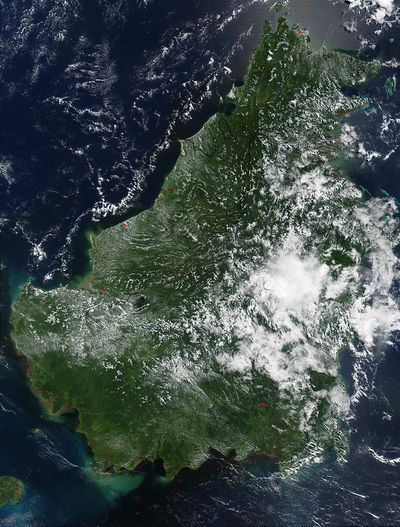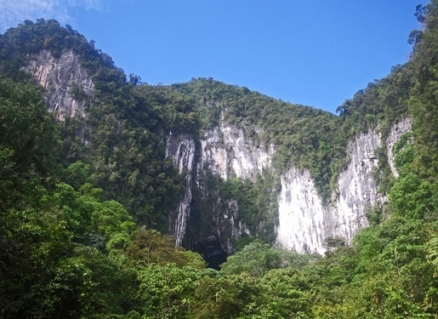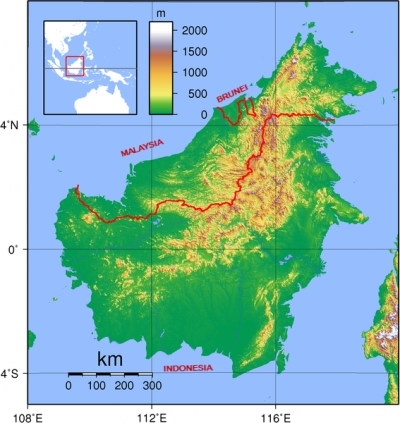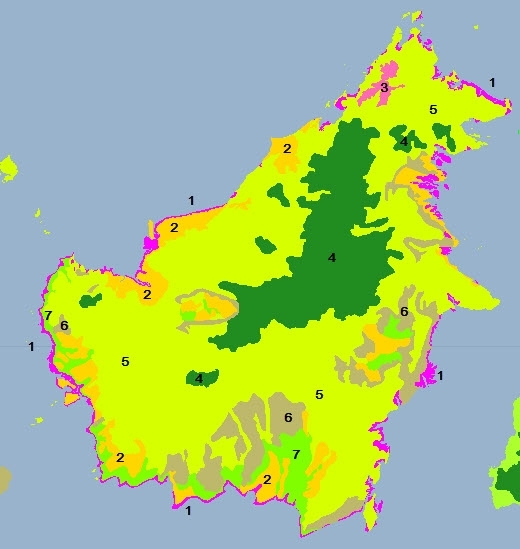Forests of Borneo
 Borneo from images taken May 17 and 19, 2002. Source: NASA Borneo from images taken May 17 and 19, 2002. Source: NASA
|
The forests of Borneo are some of the most biodiverse on Earth.
The island of Borneo is estimated have at least 222 species of mammals (44 of which are endemic), 420 resident birds (37 endemic), 100 amphibians, 394 fish (19 endemic), and 15,000 plants (Species) (6000 endemic) — more than 400 of which have been discovered since 1994.
One set of surveys tabulated over 700 tree species within a ten hectare plot — a number comparable to the total number of tree species in the entirety of Canada and the United States combined.
From a conservation point of view, the chief ongoing threats to Borneo's forests are:
(a) deforestation in order to plant commercial palm oil plantations with alien species; and
(b) forest habitat destruction in Indonesian Borneo using slash-and-burn swidden agriculture.
Politically, the island is divided between Malaysia (northern quarter of the island) and Indonesia (southern 73% of the island); with small but oil-rich nation of Brunei occupying a portion in the north.
Contents
Types of Forests in Borneo
Several distinct forest ecosystems are found across Borneo. Mangrove swamps lie along the coast, notably including the Sunda Shelf mangrove ecoregion along Borneo's north and northeast coastal zones.
Proceeding upland topographically, one encounters the Borneo peat swamp forests, which are a specialised form of dipterocarp lowland tropical rainforest.
The Borneo lowland rainforests are typically slightly higher in elevation, but sometimes include pockets of the swamp forests in localised topographic depressions.
Higher yet in elevation are the Borneo montane rainforests. Surpassing the montane forests in altitude lies a smaller area of specialised habitat termed the Kinabalu montane alpine meadows, which contains plants of lesser stature than the rainforests.
- Sunda Shelf mangroves
- Borneo peat swamp forests
- Kinabalu montane alpine meadows
- Borneo montane rain forests
- Borneo lowland rainforests
- Sundaland heath forests
- Southest Borneo freshwater swamp forests
Mangroves
See main article: Sunda Shelf mangroves
Mangrove swamps are found in estuaries and along coastal zones. The chief areas of mangrove occurrence in Borneo are along the northern coastline of the island, where the Sunda Shelf mangroves are found. Mangrove habitats cover approximately 1.2 million hectares in Borneo, a small fraction — perhaps less than 20 percent — of their original early Holocene extent. In the Indonesian state of Kalimantan large areas of mangroves have been cleared by loggers and by farmers for agriculture.
There are five major mangrove types, or consociations, recognized in the Borneo region, based on the dominant species within the genera of Avicennia, Rhizophora, Sonneratia, Bruguiera, and Nypa. The relative occurrence of each type is based on fluctuations in soils, salinity, and the tidal regime. Typically mangroves display a zonation or Succession of forests, with each zone being dominated by one of the consociations. On the seaward sediments, Avicennia-Sonneratia forest dominates. Moving inland, there is softer and deeper mud sediment dominated by Rhizophora-Bruguiera forests. Further inland, the soils become firmer and the forests display a greater species diversity. In areas with a substantial freshwater influence, Nypa palms dominate. Mangrove forests reach 50 metres (m) in height in many areas.
Peat Swamp Forests
See main article: Borneo peat swamp forests
Peat swamp forests are the dominant form of remaining lowland forest in Borneo today. These swamp forests appear in places where dead vegetation becomes waterlogged and, too wet to decompose, accumulates as peat. These tropical peat lands, formed over hundreds of years, are giant stores of carbon. Draining and/or burning these lands, releases tremendous amounts of carbon dioxide into the atmosphere. These drained areas also become highly susceptible to combustion. Under the dry el Niño conditions of 1997-98, thousands of fires raged in the peat swamps of Indonesia. Fires in peat swamps are extraordinarily difficult to extinguish because they can burn for months virtually undetected in the deeper layers of peat. In 2002 peat forests covered about ten million hectares in Borneo according to Langner and Siegert (2005).
Montane Forests
See main article: Borneo montane forests
Montane forests are generally found at an elevation from 900 metres to 3300 metres in Borneo. Trees in these forests are typically shorter than those of lowland forest, resulting in a less-developed forest canopy. Langner and Siegert (2005) estimate that in 2002 about 70 percent (1.6 million ha) of Borneo's original montane forests (2.27 million hectares) remained.
Borneo's montane flora is derived from both Asian and Australian families, making it one of Earth's most diverse montane habitats. Araucariaceae, Clethraceae, Ericaceae, Fagaceae, Lauraceae, Myrtaceae, Podocarpaceae, Symplocaceae, and Theaceae are all families commonly found in montane forests. In the lower elevations of montane forest (about 1000 to 1200 metres) the dominance of dipterocarp species ends. These are replaced with highly speciose oak (Quercus and Lithocarpus spp.) and chestnut (Castanopsis spp.) forests. Myrtaceae are also important in the lower montane forests. Above 1500 metres this forest grades into a montane ericaceous belt followed by an alpine meadow on the very highest peaks.
Three major parallel changes occur in montane forests with increasing altitude. First, there is a decrease in forest canopy height. Montane forests do not have prominent emergent trees, and their overall height is much lower. The canopy typically is 10 to 20 metres high. Second, the size and shape of the leaves change. Trees with buttresses usually are absent. Lowland forests are dominated by tree species with medium-large (mesophyll) and billowing canopy trees. Montane forests are dominated by slender trees, small leaves (microphyll), and a flattish crown surface. The third difference is the increased presence of epiphytes. Orchids, ferns, moss, lichen, and liverworts are more abundant in montane forests than in lowland rainforests. Upper montane forests share many common species and features of structure and appearance with heath forests.
Heath Forests
Heath or kerangas forest are found on well-drained, sandy soils that are extremely nutrient-poor (kerangas is the indigenous Iban word for land that will not grow rice). These forests are characterized by certain tree species tolerant of the poor, acidic soil conditions and are considerably stunted in comparison with typical rainforests. Heath forests are also less biodiverse the other tropical plant communities. MacKinnon et al. (1997) estimate that Borneo was once covered with by 6,688,200 hectares of heath forests. Today the extent of the heath forest is so diminished that estimates that almost no intact heath forests may remain in Borneo by 2015.
Lowland Dipterocarp Rainforests
See main article: Borneo lowland rainforests
Lowland Dipterocarp forests are the most biodiverse and most threatened forests in Borneo (68% of lowlands have been cleared in Kalimantan, 56% in Malaysia). These giant trees, often exceeding 45 meters in height, are the most valuable source of timber in Borneo and have been heavily logged over the past three decades. Langner and Siegert (2005) estimated that just under 30 million hectares of lowland Dipterocarp forest remained in Borneo in 2002.
The prevalence of Dipterocarps gives Borneo's forests an unusual dynamic that is tightly linked with the ocean-atmosphere phenomenon called the El Niño-Southern Oscillation (also known as ENSO or "El Niño"). According to Lisa Curran, a biologist who has spent more than 20 years in Borneo and is now a leading expert on the natural history of the island, Dipterocarp reproduction is inextricably tied to the arrival of El Niño, with 80-93% of species synchronizing their flowering to the onset of the dry weather conditions, which traditionally occur on a roughly four year basis. During a "Dipterocarp year" in Kalimantan, the canopy bursts into color as countless emergent Dipterocarp trees — each of which may have 4 million flowers — bloom during a six-week period, a strategy that intermittently starves and swamps seed predators so that at least some seeds survive to germination.
The mass blooming and subsequent fruiting — which has been known to synchronize over an area of 150 million hectares (370 million acres) and involve 1870 species — is a boon to seed predators, including wild boar, the keystone seed predator in the ecosystem. Seeds and wild boar are so prevalent during these intervals that local populations have long viewed el Niño events as times of plenty, collecting Illipe nuts for export and gorging on pork. The relationship has lasted for as long as humans have inhabited Borneo and is ingrained in the cultures of people ranging from the tribes of the forested interior to coastal traders.
In recent years however, the system seems to be breaking down due to land-use change. Dr. Curran, awarded the MacAuthur genius award in 2006 for her work in this area, says that intensive logging has taken a heavy toll on this reproductive cycle. Curran found that seed production fell from 175 pounds per acre in 1991 to 16.5 pounds per acre in 1998, even though it was a one of the strongest El Niño years on record. It appears that logging has reduced the local density and biomass of mature trees below some critical threshold that limits masting.
Further, the introduction of fires in a region that had no prior fire regime, has exacerbated drought stress and caused a radical transformation in forest ecology. Today el Niño years are no longer a time of plenty. As Curran said during a visit to California, "el Niño has become the great destroyer instead of the great provider." Land use change has broken the once tightly linked ecosystem.
The impact extends well beyond Borneo with annual fires driving widespread air pollution (often termed haze) that can spread as far as Australia, China, and India. The fires release massive amounts of carbon dioxide, especially when Borneo's peat forests burn. With 518 tons of carbon per hectare - one of the highest levels of biomass on the planet — these ecosystems can contribute up to two billion tons of carbon dioxide to the atmosphere in some years, making Indonesia the third largest greenhouse gas polluter, despite having only the world's 22nd largest economy. Some scientists worry that fires and climate change could be a positive feedback loop that only worsens conditions, producing an ever drier climate, more frequent forest fires and higher carbon emissions.
See Also
- Malaysia Geography Collection
- Mountains of Malaysia
References
- Alistar I. Robertson. 1992. Tropical mangrove ecosystems. American Geophysical Union. 329 pages
- Mario Rautner, Martin Hardiono, Raymond J. Alfred. 2005. Borneo: treasure island at risk : status of forest, wildlife, and related threats on the Island of Borneo. World Wildlife Fund, Germany. 78 pages
- Li and Sun. 1999. Palynological records since Last Glacial Maximum from a deep-sea core in the southern South China Sea. Quat. Sci. Rev. 23: 2007-2016
- Pinxian Wang. 2009. The South China Sea: Paleoceanography and Sedimentology (Google eBook) Springer. 506 pages
- Eric D.Wikramanayake. 2002. Terrestrial ecoregions of the Indo-Pacific: a conservation assessment. Island Press. 643 pages


